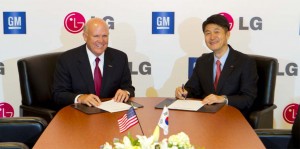Even as skeptics question the market potential for the groundbreaking Chevrolet Volt plug-in hybrid, General Motors is charging into the battery world with the latest in a series of deals aimed at making it a leader in electric propulsion.
The maker will expand its current alliance with Korean battery supplier LG Chem, the two partners saying they will work together on the development of new electric vehicles. Precisely what type of products they hope to bring to market remains to be seen, but GM has already announced it will launch more Volt-based plug-ins, including a new model for Cadillac. And, using batteries from LG Chem’s rival, A123, the Detroit maker is expected to launch its first pure battery-electric vehicle, or BEV, in 2014, TheDetroitBureau.com reported earlier this month. (For more on the A123 project, Click Here.)
“Many solutions for tomorrow’s transportation needs may be available more quickly by building on our partnership strategy,” said GM Vice Chairman Steve Girsky. ”Consumers benefit by getting the latest fuel-saving technology faster if we work with the best suppliers and we save time and money in the development process.”
LG won the shootout, several years ago, to win the contract to provide lithium-ion batteries for Volt, which GM prefers to call an extended-range electric vehicle. Its 16 kilowatt-hours pack allows it to get nearly 40 miles per charge and then switch to an onboard, gas-powered generator for longer trips.
An updated version of that pack will be used in the new Cadillac ELR, which GM approved earlier in August. (Click Here for more.) That upscale version of the Volt is based on the Caddy Converj concept that was a major hit at the 2009 Detroit Auto Show.
A senior Cadillac official tells TheDetroitBureau.com that final specifications for the ELR have not yet been determined, especially when it comes to the plug-in’s battery pack. The new model will go with a newer version of LG’s lithium formulation, which means more energy in a smaller package. “We’re not sure yet whether we will go with a smaller, lighter and less expensive pack,” the executive explained, “or provide longer range on battery power.”
Lithium-ion technology is expected to significantly improve in the years ahead, which will mean more energy out of a smaller package. But the various families of LIon batteries offer distinct behaviors that can be tailored to specific needs. The LG chemistry, for example, is currently best-suited for plug-ins, while A123’s batteries have a higher energy density – more power out of a given mass – which favors use on BEVs.
That is why, GM sources explained, a separate deal was inked with A123. Eventually, they revealed, GM is expected to launch a number of pure battery vehicles more like the Nissan Leaf than the current Chevy Volt. The first of those models is due to market around 2014.
GM’s commitment to electric propulsion has the strong support of the maker’s CEO Dan Akerson. But the effort remains controversial.
Critics point to the slow ramp-up in demand for the Volt and warn that demand may fall well short of expectations. The maker began ramping up production following a summer break at the Volt’s Detroit assembly plant. Combined with the European Opel Ampera, GM aims to sell 16,000 plug-ins this year, boosting the number to 60,000 in 2012.
It’s not the only maker that sees a significant opportunity in electric propulsion, however. Nissan is also ramping up Leaf production in Japan and will begin assembling the battery car at its Smyrna, Tennessee factory next year. Along with its French alliance partner Renault, Nissan aims to have capacity in place to produce 400,000 electric vehicles annually by mid-decade.

